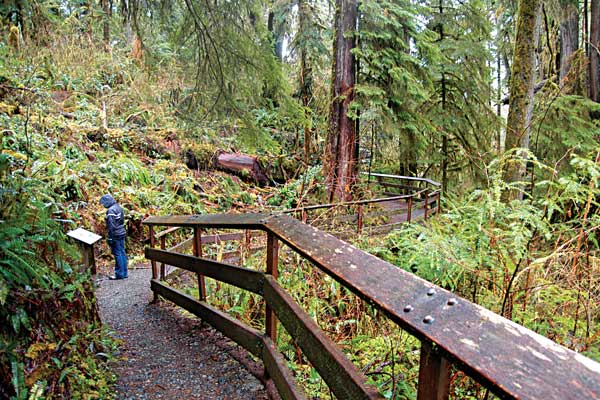The first thing you notice about Lake Quinault is the sheer magnificence of the place. If you’ve traveled on either end of U.S. Highway 101, you get sweeping views of the Pacific Ocean, but this emerald gem is tucked into the southwest region of our fair peninsula, at the joining of the Quinault Indian Nation lands, Olympic National Park and Olympic National Forest.
The second thing you notice — and, likely, this thought and the inescapable beauty of the region is predominantly what you’ll think about during your stay here — is water.
Not in the lake, really, but rather the rain. In the span of a few hours on our first day on the Lake Quinault Lodge grounds, we got the distinct impression that perhaps this place seems like a jewel in the rough.
And then I figured out why: it seemed to rain constantly. In the dawn’s early light and mid-morning, the late morning and at lunchtime. Oh, in the late afternoon, too, and dusk. Also, at night. The patter-patter on our quaint bungalow sounded like marching armies. At one point, when I’m sure I saw a line of various animals marching two-by-two with some consternation, I thought we might be in trouble.
Alas, Lake Quinault simply gets dumped on quite a bit. According to one display near the lodge, the area is only slightly wet in late July and early August. As for December through March? Forget the umbrella and bring a paddle.
Having lived most of my life in Western Washington, I was ready for the rain. My wife, who is surely a native by now after more than a dozen years here, grew up in the desert of west Texas but was similarly prepared for rain. She, however, doesn’t realize we “Warshingtonians” are part fish and are used to the fact that on really precipitative days, we can make our own broth.

Looping the loop
I should mention before I describe the hike that day hikers can enjoy Lake Quinault, but it makes for a long day if you start from the Sequim area. We stayed overnight and frankly I wish we’d stayed for several more evenings. There is a series of trails (see box) throughout this area that looked tempting and they are on my hike hit list.
We decided to be less adventurous and hike right from the lodge, heading west on Rain Forest Nature Trail, part of the South Shore hiking trails group.
The Quinault valley was formed somewhere between 10,000 and 15,000 years ago by a sheet of ice nearly 1,000 feet thick. A terminal moraine formed when the ice retreated, trapping melted water into the lake we saw.
After nine-tenths of a mile skirting the southwest edge of the lake, we turned south and into the Willaby Campground, a closed campground where we made mental notes to grab a particularly level and well-groomed site for the summer.
Just south of the campground, we turned off the main trail and onto the Rain Forest Nature Trail loop.
Here is when the lake view dropped away and the real fun began. Surrounded by lush maidenhair ferns, Douglas-firs, western hemlocks, Sitka spruces and western red cedars, we felt as though we were stepping into a tropical rain forest — minus the heat. Everything dripped life, from the yellow chanterelles, skunk cabbage and Oregon lungwort to the banana slugs underfoot.
We took the loop twice. I’d like to say it was because it was so beautiful, but really it was me missing a sign. Oops.
Despite the wet conditions, the South Shore trails are well maintained and easy to traverse. The signage is actually pretty good, as long as you’re not looking through a camera lens 85 percent of the time.
Where’s the wildlife?
Once back on the Rain Forest Nature Trail, we got the “ooooh” views. You know the type. You round a corner and before your hiking partner is at your side, she hears you go, “ooooh, nice.” The trail crosses Willaby Creek, revealing stunning views of small- to medium-sized waterfalls.
Our trail continued another 1.1 miles to a turnoff for the “Big Cedar Tree.” Since we were seeing plenty of big cedars, we figured we could skip the 3.4-mile round trip. Heading west, we encountered a massive cedar bog that reminded me of that creepy scene in one of the “Lord of the Rings” movies where Frodo sees dead people floating in the water. Moving along …
One thing our ever-present signs loved to boast about is the abundance of wildlife afforded by our regal Lake Quinault. According to the trail signs, we were in the presence of (in no particular order) river otters, Olympic torrent salamanders, osprey, American dippers, cutthroat trout, pileated woodpeckers, bobcats, black-tailed deer, red-backed voles, black bears, bull elk, Roosevelt elk, marbled murrelets, martins, carnivorous ground beetles, millipedes, red-legged frogs and — this is the one I wanted to see — the northern flying squirrel. Seriously! Bring it on!
Unfortunately the only one on the list we got to see with any detail is the red-belted polypore. A mushroom. A flying squirrel is the closest thing to a flying monkey we’re ever going to get (barring a bad science experiment) so I left a little disappointed.
At the next fork in the trail, we continued westward and across Falls Creek, affording another stunning view of a cascading waterfall.
In another six-tenths of a mile, the trail finds a bridge spanning Cascade Creek, the third and most majestic waterfall of the loop.
A half-mile later, we were back at the lodge at the end of our five-mile trek and ready for sleep. Cue the patter-patter drumbeats of rain.


